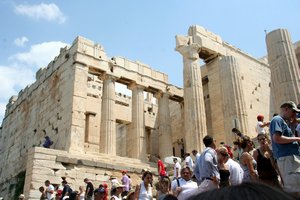Advertisement
Published: July 18th 2010

 Crowded step to the Propylaia
Crowded step to the Propylaia
It was a tough wait in line in the hot sun, but there was plenty of room once we got up these steps to the top of the hillDespite our best intentions to be on the Acropolis early in the morning, we exited the hotel and stopped for breakfast around 10. Shortly after 11 we started climbing up towards the acropolis, navigating the purchase of tickets and beverages (water is available at inexpensive vending machines once inside the Acropolis gates) as the sun beat down on us. Throngs of tourists jammed the entryway up the steps to the Propylaia and we briefly considered turning back and coming again later in the day, but once through the entryway there was much open space to walk and explore. We made a half-hearted attempt to get the kids to learn the difference between Doric and Ionic columns before making a slow circuit around the Parthenon. Clouds shielded us from direct sun for most of the visit but the heat still rendered the children unusually resistant to posing for photos. After the loop around the Parthenon we moved on to the Erechtheion, the second major structure on the hill. We saw the famed Caryatid porch -- reproductions of the Caryatids we later learned, since the originals are in the new Acropolis Museum. Andrew recalled the mythical contest between Poseidon and Athena during which

 John by the Parthenon
John by the Parthenon
Kids were too hot in the Athens sun to pose for thisZeus gave the city to Athena. Athena’s olive tree could be seen outside the Erechtheion but it was unfortunately not possible to go inside the structure to find the marks left by Poseidon’s trident. As we descended through the Acropolis towards the exit, much to the delight of Sonia and John, the kid’s excitement for the Acropolis Museum grew in proportion to their need for air conditioning. The Acropolis Museum is an architectural marvel, and in our estimation is more of a present-day inspiration than is seeing the Acropolis itself. Definitely not to be missed! It is built over ruins of the ancient city. Much of the floor is glass or has been cutaway so that the ancient city can be seen beneath the floor of the museum while walking inside. The top floor has an interior room built in the same dimensions and style as the Parthenon (with metal columns instead of marble) and has been used to organize what remains of the reliefs and sculptures that once embellished the Parthenon. Simultaneously, one is able to view the remains of the actual Parthenon and the Acropolis through the museum’s glass wall. Informatively, scale-down models of the original embellishments are

 John and Lauren by the Erechtheion
John and Lauren by the Erechtheion
The Carytid porch (where the columns are statues of young women)displayed in the interior room for comparison. This all enables the visitor to easily get a remarkable sense of the beauty of the Parthenon in its heyday, to be saddened by the ravages of time, and also to see which pieces are just plain missing. The museum does not lose the opportunity to point out how many of the missing pieces are actually at the British museum, courtesy of the reviled Lord Elgin. We could have lingered at the museum for hours, but the kids were done and we were all hungry so we made a quick visit to the gift shop and headed out. We had an unremarkable lunch in the Plaka, followed by a much-needed afternoon siesta in our air-conditioned hotel room. After a few hours to recharge, we headed back out into the still-hot evening and visited Hadrian’s Arch and what remains of the Temple of Zeus, just a few hundred yards from our hotel. We then embarked upon an ambling souvenir-shopping wander across the Plaka. The kids obtained some fine souvenirs for themselves and as gifts for friends and we fought off the increasingly frequent and insistent restaurateurs as we made our way towards our 8:30

 John, Sonia, Andrew at the Temple of Zeus
John, Sonia, Andrew at the Temple of Zeus
Also know as the Olympieion, this temple is nothing if not massive. Photo taken by Lauren.reservation (tourist dinner hour - the natives don’t eat until at least 9:30) on the terrace at Kuzina. We got slightly lost on the way but ultimately discovered the restaurant in a very pretty part of the Plaka that we had not previously visited. The rooftop restaurantant had great views of the Acropolis and the Temple of Hephaestus lit up at night and the menu was quite enticing. We noted with some amusement that lunch is served until 7pm. We had an Asian-flavored calamari appetizer along with our first sampling of grilled octopus. We had a pleasant walk home during which Andrew acquired one more souvenir for himself - a green laser pointer with a diffracting lens enabling him to make cool geometric patterns. We enjoyed being able to retreat to our air-conditioned room and unwind with a little television before sleep at around midnight.
Advertisement
Tot: 0.213s; Tpl: 0.028s; cc: 12; qc: 74; dbt: 0.075s; 1; m:domysql w:travelblog (10.17.0.13); sld: 1;
; mem: 1.2mb











